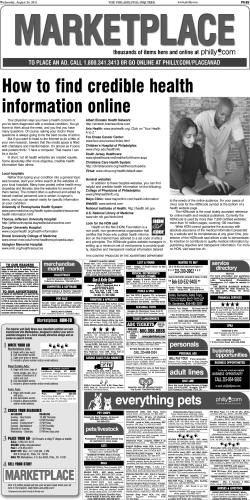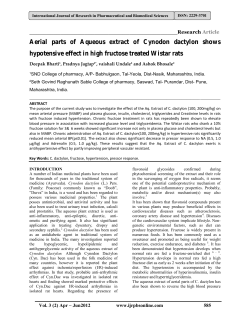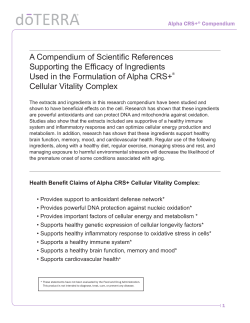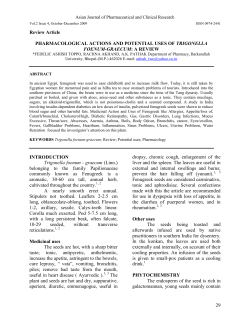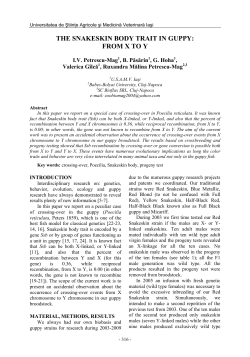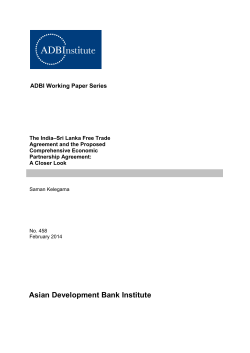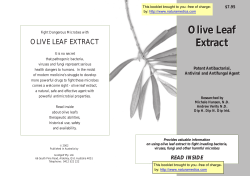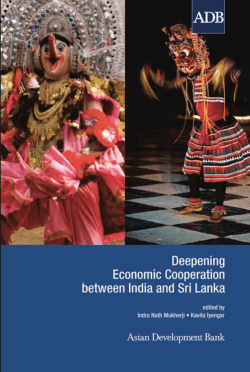
Adverse pregnancy outcome in rats Salacia reticulata
Brazilian Journal of Medical and Biological Research (2003) 36: 931-935 Salacia reticulata and pregnancy outcome ISSN 0100-879X 931 Adverse pregnancy outcome in rats following exposure to a Salacia reticulata (Celastraceae) root extract W.D. Ratnasooriya1, J.R.A.C. Jayakody1 and G.A.S. Premakumara2 1Department of Zoology, University of Colombo, Colombo, Sri Lanka Products Development Group, Industrial Technology Institute, Colombo, Sri Lanka 2Natural Abstract Correspondence W.D. Ratnasooriya Department of Zoology University of Colombo Colombo 03 Sri Lanka Fax: 94-1-503148 E-mail: [email protected] Received February 15, 2002 Accepted February 14, 2003 The root extract of Salacia reticulata Wight (family: Celastraceae) is used in Sri Lanka by traditional practitioners as a herbal therapy for glycemic control even during pregnancy. It is recognized that some clinically used antidiabetic drugs have harmful effects on pregnancy but the effects of the S. reticulata root extract on reproductive outcome is unknown and deserves examination. We determined the effects of the S. reticulata root extract on the reproductive outcome of Wistar rats (250-260 g) when administered orally (10 g/kg) during early (days 1-7) and mid- (days 7-14) pregnancy. The root extract significantly (P<0.05) enhanced post-implantation losses (control vs treatment: early pregnancy, 4.7 ± 2.4 vs 49.3 ± 13%; mid-pregnancy, 4.7 ± 2.4 vs 41.7 ± 16.1%). Gestational length was unaltered but the pups born had a low birth weight (P<0.05) (early pregnancy, 6.8 ± 0.1 vs 5.3 ± 0.1 g; mid-pregnancy, 6.8 ± 0.1 vs 5.0 ± 0.1 g) and low birth index (P<0.05) (early pregnancy, 95.2 ± 2.4 vs 50.7 ± 12.9%; mid-pregnancy, 95.2 ± 2.4 vs 58.3 ± 16.1%), fetal survival ratio (P<0.05) (early pregnancy, 95.2 ± 2.4 vs 50.7 ± 12.9; mid-pregnancy, 95.2 ± 2.4 vs 58.3 ± 16.1), and viability index (P<0.05) (early pregnancy, 94.9 ± 2.6 vs 49.5 ± 12.5%; mid-pregnancy, 94.9 ± 2.6 vs 57.1 ± 16.1%). However, the root extract was non-teratogenic. We conclude that the S. reticulata root extract can be hazardous to successful pregnancy in women and should not be used in pregnancy complicated by diabetes. Introduction In Sri Lanka, many people including pregnant women use either a water extract of Momordica charantia L (Cucubitaceae) or roots of Salacia reticulata Wight (Celastraceae) as a herbal therapy for diabetes mellitus. Currently, even mugs made of S. reticulata wood are available to be used routinely by diabetic patients to drink water. Experimentally, the root extract of S. reticulata has Key words • • • • • Salacia reticulata Hypoglycemia Pregnancy outcome Birth weight Postnatal development been found to have potent hypoglycemic activity both in normal (1,2) and in streptozotocin-induced diabetic rats (1,3) and spermicidal activity against human spermatozoa (4). Furthermore, the decoction of S. reticulata roots is used in the treatment of rheumatism, gonorrhea, itching and swelling, asthma, thirst, amenorrhea and dysmenorrhea (1). Phytochemically, the presence of a variety of chemical constituents such as 1,3-diketones, dulcitol and leucopelargonidin (a linear isoBraz J Med Biol Res 36(7) 2003 932 W.D. Ratnasooriya et al. mer of natural rubber), iguesterin (quinonemethides), mangiferin and epicatechin (phenols), phlobatannin and glycosidal tannins, triterpenes, 30-hydroxy-20(30) dihydroisoiguesterin, salacinol and kotalanol (thiosugar) has been detected in the root of S. reticulata (1,4-7). However, treatment with oral hypoglycemic agents in gestational diabetes mellitus remains a controversial topic since even a minor degree of hypoglycemia can adversely affect the reproductive outcome. Recently, we showed that water extracts of M. charantia fruit, if administered during mid-pregnancy (days 7-14) to rats, induced prenatal growth deficiencies (8) and mild teratogenesis (9), as reported with some clinically used antidiabetic drugs in Western medicine (10). Regrettably, the possible harmful effects on pregnancy outcome after in utero exposure to a water extract of S. reticulata have not been investigated. Therefore, the aim of the present study was to determine the effect of an aqueous extract of S. reticulata roots on reproductive outcome and on prenatal and early postnatal development using the rat model at a dose equivalent to ten times the recommended human dose (1,11). Material and Methods Plant material Dried S. reticulata roots were purchased from a herbal outlet and authenticated by Dr. Y.M.H.B. Yapabandara, Natural Products Development Group, Industrial Technology Institute, Colombo, Sri Lanka. A voucher specimen has been deposited in the museum of the Department of Zoology, University of Colombo (specimen number 1SR). Extract preparation Sixty grams of powdered root was boiled in 1920 ml distilled water for approximately Braz J Med Biol Res 36(7) 2003 3 h until a final 24-ml volume of extract was obtained (yield: 40%, w/v). Animals Nulliparous pregnant (days 1 and 7) Wistar rats (250-260 g) were used. Pregnancy was induced in rats by individually pairing a proestrous female overnight with a sexually experienced male (between 17:00 and 18:00 h) and examining vaginal smears for the presence of sperm on the following day, which is designated as day 1 of pregnancy. They were placed individually in plastic cages under standardized animal house conditions (temperature: 28-31ºC; light: approximately 12 h natural light per day; humidity: 50-55%) with free access to pelleted food (Master Feeds Ltd., Colombo, Sri Lanka) and tap water. Study protocol Twenty-three pregnant rats were randomly assigned to four groups and treated (between 9:00-10:00 h for 7 consecutive days) in the following manner: group 1 (N = 4), 1 ml distilled water po; group 2 (N = 6), 1 ml root extract (10 g/kg) po from days 1 to 7 of pregnancy; group 3 (N = 6), 1 ml distilled water po; group 4 (N = 7), 1 ml root extract (10 g/kg) po from days 7 to 14 of pregnancy. Due to ethical reasons, the number of animals was minimized. Cage-side examinations were performed daily to detect overt signs of toxicity (salivation, rhinorrhea, lacrimation, chewing jaw movements, ptosis, squinting, writhing, convulsions, tremors, yellowing of fur, loss of hair), stress (erection of fur, vocalization and exophthalmia), behavioral abnormalities, and moribund or dead rats. Food and water intake was also determined by measuring the daily leftovers in the cages (12). On day 15 of pregnancy, the rats were laparotomized under ether anesthesia and aseptic conditions. The uteri were examined in situ 933 Salacia reticulata and pregnancy outcome for the presence and location of resorption sites and for live and dead fetuses. The appearance and the number of corpora lutea in each ovary were also recorded. The animals were sutured, treated with 190 mg/kg tetracycline im, and allowed to deliver, and the day of parturition was recorded. The number of viable or stillborn pups was recorded, and their body weights were determined. All pups were evaluated for gross external congenital abnormalities (open eyelids, tail anomalies, clubfoot, oligodactyly or syndactyly). Pup mortality up to 6 days, the day of eye opening, and the appearance of fur were recorded. Based on these data, the following indices were computed (13): quantal pregnancy = (number of pregnant dams/number mated) x 100; implantation index = (total number of implants/number mated) x 100; pre-implantation loss = [(number of corpora lutea number of implantations)/number of corpora lutea] x 100; post-implantation loss = [(number of implantations - number of viable implantations)/number of implantations] x 100; viability index = (number of viable pups on day 4 after delivery/number of liveborn pups) x 100; birth index = (number of pups born/number of implantations) x 100; fetal survival ratio = (number of surviving pups/number of implantations) x 100; live birth index = (number of liveborn pups/total number of pups born) x 100; gestation index = (number of live pups/number of pregnant dams) x 100. signs of maternal toxicity, stress or abnormal behavioral changes were observed. None of the pregnant rats showed vaginal bleeding or expulsion of products of conception. The food and water intake of the treated rats was similar to that of controls. At laparotomy, all the extract-treated rats had normal numbers of apparently healthy looking corpora lutea, as observed in controls. Since there was no significant difference between the two control treatments (groups 1 and 3) the data for these groups were pooled. Data concerning reproductive parameters are presented in Table 1. The root extract caused a marked and significant (P<0.01) increase in post-implantation losses when given during either early or late pregnancy. There was no significant difference in any other parameter monitored or computed. The results obtained concerning the pups are presented in Table 2. Neither parturitionrelated maternal deaths nor stillbirths were observed. The root extract induced a signifiTable 1. Effect of an aqueous extract of Salacia reticulata roots on some reproductive parameters of female rats. Parameter Control (N = 10) Early pregnancy (N = 6) Mid-pregnancy (N = 7) No. of uterine implants 6.7 ± 0.21 (6-8) 8.6 ± 0.8 (5-10) 8.8 ± 0.7 (6-12) Quantal pregnancy (%) 100 100 100 Implantation index (%) 670 866.6 885.7 Pre-implantation loss (%) 18.4 ± 1.4 (12.5-25) 19.6 ± 3.6 (10-37.5) 15.4 ± 3.3 (9-33.5) Post-implantation loss (%) 4.7 ± 2.4 (0-16.6) 49.3 ± 13* (12.5-100) 41.7 ± 16.1* (0-100) 100 83.3 71.4 21.3 ± 0.2 (21-23) 23.0 ± 0.6 (21-26) 21.6 ± 0.3 (21-24) Statistical analysis Data are reported as means ± SEM. Statistical comparisons were made using the Gtest (a modified chi-square test) and the Mann-Whitney U-test (14), with the level of significance set at P<0.05. Results No mortality or treatment-related overt Gestation index (%) Mean gestational length (days) The rats received 10 g/kg, po, daily from day 1 to day 7 of pregnancy (early pregnancy group) or from day 7 to day 14 (mid-pregnancy group). Data are reported as means ± SEM (range within parentheses). *P<0.05 compared to control (Mann-Whitney U-test and G-test). See Methods for definition of indices. Braz J Med Biol Res 36(7) 2003 934 W.D. Ratnasooriya et al. cant reduction (P<0.01) in the weight of the pups born (22% in early pregnancy and 27% in mid-pregnancy), in viability index at day 4 after delivery, and in birth index and fetal survival ratio. Discussion Oral administration of the S. reticulata root extract during early or mid-pregnancy had no effect on fertility in terms of uterine implants, implantation index or gestation index. However, it posed a considerable threat to successful pregnancy (as judged by a reduction of fetal survival ratio and birth index and enhancement of post-implantation losses). These deleterious effects on pregTable 2. Effect of an aqueous extract of Salacia reticulata roots on some litter parameters of female rats. Parameter Control (N = 10) Early pregnancy (N = 6) Mid-pregnancy (N = 7) Number of pups born 6.4 ± 0.3 (5-8) 4.6 ± 1.1 (0-7) 5.7 ± 1.7 (0-12) Number of liveborn pups 6.4 ± 0.3 (5-8) 4.6 ± 1.1 (0-7) 5.7 ± 1.7 (0-12) Pup weight (g) 6.8 ± 0.1 (5.9-7.2) 5.3 ± 0.1* (4.8-5.8) 5.0 ± 0.1* (4.8-5.2) 0.0 0.0 0.0 14.9 ± 0.2 (14-17) 14.8 ± 0.5 (14-17) 15.5 ± 0.5 (14-17) 7.3 ± 0.21 (6-8) 7.2 ± 0.3 (6-8) 7.4 ± 0.3 (6-8) 100 100 100 Viability index (%) 94.9 ± 2.6 (83.3-100) 49.5 ± 12.5* (0-85.71) 57.1 ± 16.1* (0-100) Birth index (%) 95.2 ± 2.4 (83.3-100) 50.7 ± 12.9* (0-85.71) 58.3 ± 16.1* (0-100) Fetal survival ratio 95.2 ± 2.4 (83.3-100) 50.7 ± 12.9* (0-85.7) 58.3 ± 16.1* (0-100) Number of malformed pups Eye opening (days) Appearance of fur (days) Live birth index (%) The rats received 10 g/kg, po, daily from day 1 to day 7 of pregnancy (early pregnancy group) or from day 7 to day 14 (mid-pregnancy group). Data are reported as means ± SEM (range within parentheses). *P<0.05 compared to control (Mann-Whitney U-test and G-test). See Methods for definition of indices. Braz J Med Biol Res 36(7) 2003 nancy resulted from enhanced embryonic deaths as evident at laparotomy possibly at an early stage of prenatal development since no signs of vaginal bleeding or expulsion of products of conception were evident. Since the root extract was non-toxic, and a correlation exists between maternal toxicity and developmental toxicity (15), the fetal deaths are unlikely to be due to a toxic action on the developing offspring. On the other hand, there could possibly be an indirect effect of maternal hypoglycemia. This is a matter of concern, especially for women who are diabetic and are at high risk of miscarriage. The pups born to dams treated with the root extract had low mean birth weights. This indicates intrauterine growth retardation (IUGR). Some antidiabetic drugs induce IUGR (16). The degree of IUGR observed with the use of the root extract, however, was lower than that reported for M. charantia fruits (8). The IUGR in this study was not due to reduction of gestational length or preterm delivery, and was probably not due to intrinsic fetal factors such as chromosomal abnormalities or other malformations. However, it may be attributed to impaired glucose supply to the fetuses. Extremely potent natural α-glucosidase inhibitors, salacinol (6) and kotalanol (5), have been isolated from S. reticulata roots, and several workers have shown that the root extracts of S. reticulata reduce blood glucose levels in normoglycemic and streptozotocin-induced diabetic rats (1,3). The root extract appeared to be non-teratogenic. On the other hand, allopathic antidiabetic agents like sulfonylureas and biguanides (10,17), and plant products such as M. charantia fruit extracts (9) induce teratogenesis in rodents. The viability index of pups born following fetal exposure to the root extract was low, although some parameters of postnatal development (day of eye opening and day of appearance of fur) remained unaltered. If these data can be applied to women, then consumption of the root extract during preg- 935 Salacia reticulata and pregnancy outcome nancy can have serious implications in countries like Sri Lanka, India and Nepal where more than two thirds of all infants born are small for gestational age (18). Low birth weight has a major influence on neonatal morbidity, neurocognitive deficiencies, neurobehavioral effects and mortality (19). Fur- thermore, reduced growth in utero is reported to be linked to decreased glucose tolerance in adult life (20). We conclude that the use of the S. reticulata extract should be avoided by women with pregnancy complicated by diabetes. References 1. Tissera MHA & Thabrew MI (2001). Medicinal Plants and Ayurvedic Preparations Used in Sri Lanka for the Control of Diabetes Mellitus. A publication of the Department of Ayurveda, Ministry of Health and Indigenous Medicine, Sri Lanka. 2. Karunanayake EH, Welihinda J, Sirimanne SR & Sinnadorai G (1984). Oral hypoglycaemic activity of some medicinal plants of Sri Lanka. Journal of Ethnopharmacology, 11: 223-231. 3. Serasinghe S, Serasinghe P, Yamazaki H, Nishiguchi K, Hombhanje F & Nakanishi S (1990). Oral hypoglycemic effect of Salacia reticulata in the streptozotocin induced diabetic rat. Phytotherapy Research, 4: 205-206. 4. Premakumara GAS, Ratnasooriya WD, Balasubramanium S, Dhanabalasingham B, Fernando HC, Dias MN, Karunaratne V & Gunatilaka AL (1992). Studies on terpenoids and steroids. Part 241. The effect of some natural quinonemethide and 14 (15)-enequinonemethide nortriterpenoids on human spermatozoa in utero. Phytochemistry, 11: 219-223. 5. Yoshikawa M, Murkamy T, Yashiro K & Matsuda H (1998). Kotalanol, a potent alpha glucosidase inhibitor with thiosugar sulfonium sulphate structure from antidiabetic Ayurvedic medicine Salacia reticulata. Chemical and Pharmaceutical Bulletin, 46: 1339-1340. 6. Yoshikawa M, Murkamy T, Shimada H, Yamahara J, Tanabe G & Muraoka O (1997). Salacinol, potent antidiabetic principle with unique thiosugar sulfonium sulphate structure from the Ayurvedic traditional medicine Salacia reticulata in Sri Lanka and India. Tetrahedron Letters, 38: 8367-8370. 7. The Wealth of India, Raw Materials (1976). Publications and Information Directorate. Hillside Road, New Delhi, India. 8. Fernandopullae BMR & Ratnasooriya WD (1999). The safety profile in pregnant rats of an antidiabetic agent extracted from Momordica charantia. Medical Science Research, 27: 663-665. 9. Fernandopullae BMR & Ratnasooriya WD (1999). Teratogenic effects of an extract of unripe Momordica charantia fruit in rats. Medical Science Research, 27: 807-809. 10. Piacquadio K, Hollingworth DR & Murphy H (1991). Effects of in utero exposure to oral hypoglycaemic drugs. Lancet, 338: 866-869. 11. Jayasinghe N (1994). Osuturu Visituru. In: Weragoda PB (Editor), Osuthuru Visithuru. Part 111. Department of Ayurveda, Colombo, Sri Lanka. 12. Staff of UFAW (1966). The UFAW Handbook on the Care and Management of Laboratory Animals. E & S Livingston Ltd., Edinburgh, UK. 13. Jayatunga YNA, Dangalle CD & Ratnasooriya WD (1998). Hazardous effects of carbofuran on pregnancy outcome of rats. Medical Science Research, 26: 33-37. 14. Sokal RR & Rohlf FJ (1981). Biometry. 2nd edn. Freeman, San Francisco, CA, USA. 15. Ema H, Kurosaka R, Harazono A, Amano H & Ogawa Y (1996). Phase specificity of developmental toxicity after oral administration of mono-n-butyl phthalate in rats. Archives of Environmental Contamination and Toxicology, 31: 170-176. 16. Pond SM (1996). Medicine in Pregnancy. 1st edn. Australian Government Publishing Service, Canberra, Australia. 17. Lazarow A, Carpenter AM, Morgan C & Wright G (1962). Effects of long-term administration of tolbutamide in normal, sub-diabetic and diabetic rats. Diabetes, 11: 103-115. 18. WHO (1994). Multicentre study on low birth weight and infant mortality in India, Nepal and Sri Lanka. South Asia Regional Organization, No. 25, New Delhi, India. 19. Han S, Pfizenmair DH, Gracia E, Eguez ML, Ling M, Kemp W & Bogden JD (2000). Effects of lead exposure before pregnancy and dietary calcium during pregnancy on fetal development and lead accumulation. Environmental Health Perspectives, 108: 527-531. 20. Ravelli ACJ, Van der Meulen JHP, Micheis RPJ, Osmond C, Barker DJP, Hales CN & Bleker OP (1998). Glucose tolerance in adults after prenatal exposure to famine. Lancet, 351: 173-177. Braz J Med Biol Res 36(7) 2003
© Copyright 2026










